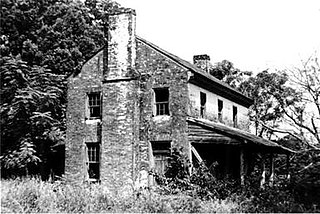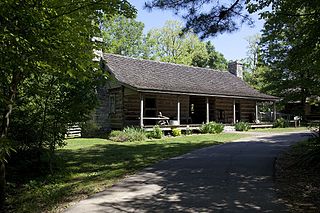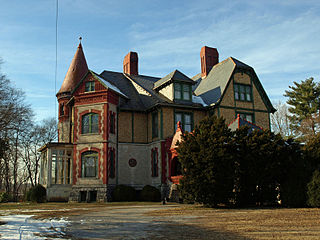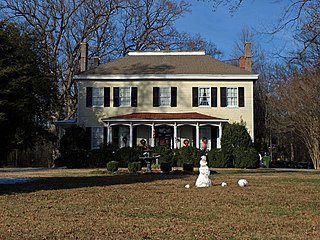
Huntsville is a city in Madison County and Limestone County, Alabama, United States, with a small portion extending into Morgan County. It is the county seat of Madison County. Located in the Appalachian region of northern Alabama, Huntsville is the most populous city in the state.

The Spencer–Peirce–Little Farm is a Colonial American farm located at 5 Little's Lane, Newbury, Massachusetts, United States, in the midst of 231 acres (93 ha) of open land bordering the Merrimack River and Plum Island Sound. The farmhouse, dating to c. 1690, was designated a National Historic Landmark in 1968 as an extremely rare 17th-century stone house in New England. It is now a nonprofit museum owned and operated by Historic New England and open to the public several days a week during the warmer months; an admission fee is charged for non Members.

The dogtrot, also known as a breezeway house, dog-run, or possum-trot, is a style of house that was common throughout the Southeastern United States during the 19th and early 20th centuries. Some theories place its origins in the southern Appalachian Mountains. Some scholars believe the style developed in the post-Revolution frontiers of Kentucky and Tennessee. Others note its presence in the South Carolina Lowcountry from an early period. The main style point was a large breezeway through the center of the house to cool occupants in the hot southern climate.

The McGehee–Stringfellow House, also known as Oak Grove, was a historic plantation house near Greensboro, Alabama, United States. It was added to the National Register of Historic Places on September 17, 1980, due to its architectural significance. It was accidentally destroyed in the 1980s during an attempt to move it to another location.

Lincoln School is a historic school building in Huntsville, Alabama. Built in 1929 as part of the Lincoln Mill Village, the school became part of the city school system in the 1950s. The city sold the building to a private school in 2011. It was listed on the National Register of Historic Places in 1982.

Burritt on the Mountain is an open-air museum in Huntsville, Alabama. The museum grounds on Round Top Mountain, a plateau connected to Monte Sano Mountain, were the estate of local physician William Burritt, who willed his house and land to the city for use as a museum upon his death in 1955. A number of 19th-century rural structures have been added to Burritt's mansion, both in the interest of historical preservation and life re-enactment.

The Urquhart House is a historic residence in Huntsville, Alabama. The property was acquired by Allen Urquhart in 1813, and the house was built soon after. The dogtrot house was built in several phases, with the eastern "pen" being the original section. It was originally built as a one-room log house with a 7-foot (2.1-meter) ceiling. The house was extensively modified around 1835; the ceiling was raised to 9 feet 2 inches (2.79 m), and many Federal-period details were added, including beaded chair rails and baseboards, an elaborate mantle, and lath and plastered walls. The second floor and western pen may have been added at this time; most of the original details were removed from the western pen in the early 20th century, making it difficult to date its construction. When it was completed, the house's dogtrot form was established, including loft rooms over both pens and the breezeway. An addition was made in the 1860s or 1870s to the rear of the western pen which features a Greek Revival mantle. In circa 1915–1930, a kitchen was added to the rear of this room, and an enclosed porch was built in the ell along the rear of the house. A front porch was added in the middle of the 20th century.

The Kildare–McCormick House is a historic residence in Huntsville, Alabama. The highly ornate, Queen Anne-style mansion was built in 1886–87. Its early owners contributed to the development of Huntsville, both through industrial projects and philanthropic efforts. The house was listed on the National Register of Historic Places in 1982.

Oak Place is a historic residence in Huntsville, Alabama. It was built by renowned Huntsville architect George Steele in 1840 on 320 acres. Steele designed a number of buildings across the South, including the First National Bank building in Huntsville, and the second Madison County Courthouse, which stood from 1840 until 1914. Similar to many of his buildings, Steele designed the Oak Place house in a Greek Revival style, although much more restrained in detail.

Quietdale is a historic residence in Huntsville, Alabama, US. The house was built in 1854 for Caroline Moore Robinson, the widow of Madison County Sheriff William Robinson. It represents a shift in architecture from Neoclassical to the more eclectic forms that became prominent in the late 19th century.

The Phelps–Jones House is a historic residence in Huntsville, Alabama. One of the oldest buildings in Alabama, it was built in 1818, shortly after the initial federal land sale in Madison County in 1809. Despite having many owners, the original character of the house has remained. The two-story house is built of brick laid in Flemish bond, and has Federal and Georgian details. The original block has a bedroom and parlor separated by a central hall, with a dining room in an ell to the northeast. Staircases in the hall and dining room led to three bedrooms on the second floor. In 1956, a porch in the crook of the ell was enclosed, adding a bathroom and small bedroom. Another porch off the rear of the dining room was enclosed and converted into a kitchen. Interior woodwork, including six mantels, is in provincial Federal style. The façade is five bays wide, with twelve-over-twelve sash windows on the ground floor and twelve-over-eight on the second. A narrow hipped roof porch covers the double front door; originally a wider porch covered a single door flanked by narrow sidelights and topped with a transom. The house was listed on the Alabama Register of Landmarks and Heritage in 1979 and the National Register of Historic Places in 1982.

Greenlawn is a historic residence between Meridianville and Huntsville, Alabama. The house was built in 1849–50 by William Otey, replacing a log house built by his father in the early 1810s. Following William and his wife's deaths, the house was taken over by one of their granddaughters in 1907. Around 1925, the original Italianate portico was replaced with the current Greek Revival entrance, and a northern wing was added. The house fell vacant in 1963 and was later restored, now sitting at the entrance to a subdivision of the same name.

The First National Bank is a historic bank building in Huntsville, Alabama. The temple-form Greek Revival structure was built in 1835–1836. Designed by locally famous architect George Steele, it occupies a prominent position, facing the courthouse square and sitting on a bluff directly above the Big Spring. It was the longest-serving bank building in Alabama, operating until 2010 when Regions Bank moved their downtown branch to a new location. The building was listed on the National Register of Historic Places in 1974.

The Humphreys–Rodgers House is a historic residence in Huntsville, Alabama. Since its construction in 1848, it has been expanded and altered at least three times, saved from demolition twice, and moved once. The house was built by David Campbell Humphreys, a four-term member of the Alabama House of Representatives and anti-secessionist during the Civil War.

The Jude–Crutcher House is a historic plantation house in Huntsville, Alabama. The house was built circa 1812 on land deeded that year to Samuel Echols. Echols sold 54 acres and the house to George Jude, Sr., in 1817. Jude died two years later, leaving the land to his son, George Jr. The younger Jude eventually acquired 800 acres and owned 31 slaves. Upon his death in 1873, the land stayed in the family until 1883. In 1906 David Crutcher, who had been born a slave on an adjacent plantation in 1851, purchased the house and 154 acres along with two other African-American men. The Crutchers operated a successful farm on their portion of the land, which was an extension farm for Alabama A&M University until the 1940s. Only 7% of African-American farmers in Madison County in 1910 owned their own farms. David died in 1924, and his wife, Lucy, died in 1943, although the house and land is still in the family.

The William Lanford House is a historic residence in Huntsville, Alabama. The house was built by William Lanford, a native of Spotsylvania County, Virginia. Lanford's father, Robert, was an early land speculator who came to Huntsville from Nashville along with LeRoy Pope. William purchased 1,975 acres in 1843 and built his house in 1850. Lanford's daughter, Mary, married physician John R. Slaughter in 1853, who later moved his practice to the house in William Lanford's later life. Upon his death in 1881, the land was divided among Lanford's daughters, with Mary and Dr. Slaughter remaining in the house. After Mary's death in 1913, the house was sold to William Olin Camper in 1919. Camper and his brother Robert were merchants in Madison and Huntsville, and owned the Twickenham Hotel in Huntsville.

The Ford–Countess House is a historic residence near Huntsville in Madison County, Alabama. Hezekiah Ford came to Madison County from Cumberland County, Virginia, in 1813, and began purchasing land on which to build a cotton plantation. He acquired the land on which the house stands in 1820, and built the two-story, brick I-house soon after. Ford died in 1839, and the land was owned by his wife, Nancy, until her death in 1844. Hezekiah's brother, John, then assumed ownership, and the plantation stayed in his family until 1904. It reached a peak of 280 acres, and the family owned 69 slaves in 1860. James W. Burcum owned the property from 1904 until 1911, when it was sold to Stephen H. Countess of Tuscaloosa. The Countess family still owns and farms the land, although the house has not been occupied since 1995.

The Vance C. Larmore House is a historic residence near Hammondville, Alabama. Larmore came to DeKalb County from Abingdon, Virginia, around 1838. One of the earliest white settlers in the county following the Cherokee removal, he built one of the largest farms in the mountainous area, amassing 1700 acres by 1860. In the mid-1840s, Larmore built a two-story I-house, a Vernacular form brought from the East to what was then the frontier. The house is clad in clapboard, and has a Victorian-detailed front porch, which was a later addition. The interior has a center-hall plan on each floor, as well as a one-story ell off the rear, containing a kitchen and dining room. The house was listed on the Alabama Register of Landmarks and Heritage in 1979 and the National Register of Historic Places in 2004.

The Swindler House, in Shelby County, Kentucky, near Cropper, Kentucky, is a "Settlement Vernacular" home that was built c. 1825 – c. 1835 and expanded later. It was listed on the National Register of Historic Places in 1988.























